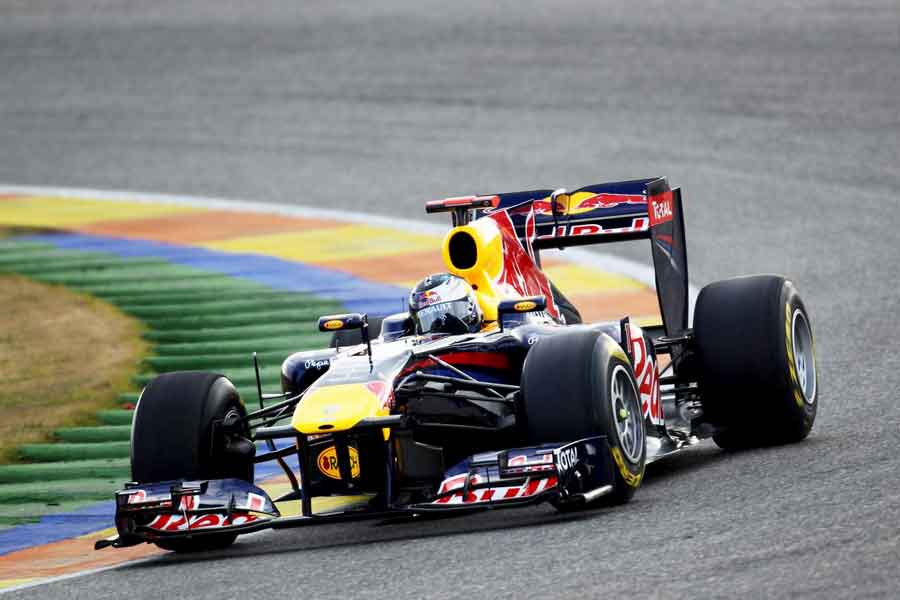Red Bull RB7 - One of the Most Convincing Formula 1 Championship Winning Cars
The Red Bull RB7 was the 2011 Formula 1 World Championship winning car. Sebastian Vettel won his second of four consecutive titles, just as his team Red Bull Racing.
Red Bull RB7 was as fast as his predecessor but more reliable
This car continued the evolution started with RB5 and was even more successful than RB6. The Red Bull RB7 again was much faster than the rest of the grid and much more reliable than its predecessor. The new car was pretty the same like the previous one but had to meet several rule changes. That resulted with much simpler diffuser than on the RB6 and the shorter fin on the engine cover. Another change was the return of the KERS (Kinetic Energy Recovery System) and Red Bull easily adopted it.

Launch of Red Bull Racing team’s RB7 in Valencia
The Red Bull RB7 was presented in February at Ricardo Tormo Circuit in Valencia and right from the start it was clear that no other car can compete with a new brainchild of Adrian Newey and his team. Already in the pre-season test, Sebastian Vettel was much faster than the others, while his teammate Mark Webber was off the pace, which was most likely down a problem with the chassis.
Almost the perfect season
However, the season of 2011 was an excellent one for the team. Vettel won the title with a margin of 122 points to Jenson Button who was a runner-up, while Webber finished 3rd in the Drivers’ championship. In the Constructors’ championship, Red Bull-Renault team picked a total of 650 points what was 153 more than McLaren-Mercedes who finished the season as a vice-champion.

Red Bull RB7 Renault was dominant from the start of the 2011 Formula 1 season
The start of the season was expectedly good. Vettel won the races in Australia and Malaysia, while Webber finished 5th in Melbourne and 4th at Sepang. The Chinese Grand Prix was the first race of the season which wasn’t won by Red Bull RB7. Vettel was 2nd and Webber 3rd, but it was followed by a 1-2 finish in Turkish Grand Prix in which the German driver scored his third win of the year.
Sebastian Vettel was absolutely dominant in the first half of the year
Vettel’s fine form continued and he won the races in Spain and Monaco, while the Australian driver finished 4th in both. After finishing 2nd (Vettel) and 3rd (Webber) in Canada, the defending champion won the European Grand Prix at Valencia Street Circuit, while Webber was 3rd. At that point of the season, Vettel topped the standings with an advantage of 77 points to Button and Webber, while the Austrian team was 89 points ahead of McLaren in the Constructors’ championship.
Video – Red Bull RB7 onboard
Short crisis and quick recovery
In the following three races, the results were slightly below expectations. Red Bull RB7 failed to win at Silverstone, Nurburgring, and Hungaroring, but the two drivers regularly picked points and their positions in the overall standings weren’t threatened.

When Red Bull RB7 was rolled out, it was clear it was a neat development of the RB6, but this wasn’t an innovative car
However, the team quickly recovered and Vettel returned to the winning path. He won the races in Belgium, Italy, and Singapore, while Webber twice was at the podium. With five races to go, it was clear that Red Bull RB7 will take both titles. Interestingly, Vettel secured the title in the following race, finishing 3rd in the Japanese Grand Prix. Red Bull Racing defended its Constructors’ championship title after the Korean Grand Prix. Vettel won that race and Webber finished 3rd.
Impressive numbers
The last three races of the season were just a formality for the Red Bull drivers. Vettel won in India, while his teammate finished 4th. In Abu Dhabi, German driver enrolled the only retirement in 2011, while the Australian again was 4th. Finally, in the last race of the year in Brazil, Webber managed to win after Vettel had gearbox troubles and finished 2nd, what was team’s third 1-2 finish of the campaign.

Red Bull Racing team celebrates another victory of Red Bull RB7
The season of 2011 was really special for the Red Bull Racing and their RB7 which won 12 out of 19 races and also had 27 podiums, 18 pole positions, 10 fastest laps, and also had only two retirements.
Red Bull RB7 technical specifications
Chassis: Carbon-fibre composite and honeycomb monocoque
Front suspension: Double wishbones, push-rod actuated torsion bar springs, Multimatic dampers
Rear suspension: Double wishbones, pull-rod actuated torsion bar springs, Multimatic dampers
Engine: Renault RS27-2011, 2400cc V8 naturally aspirated mid-longitudinally mounted at 90 degrees, limited to 18.000 RPM with KERS
Transmission: 7-speed semi-automatic gearbox with reverse gear
Brakes: Brembo ventilated carbon ceramic discs
Clutch: AP Racing
Weight: 640 kg
Tires: Pirelli Pzero
Fuel: Total Group



